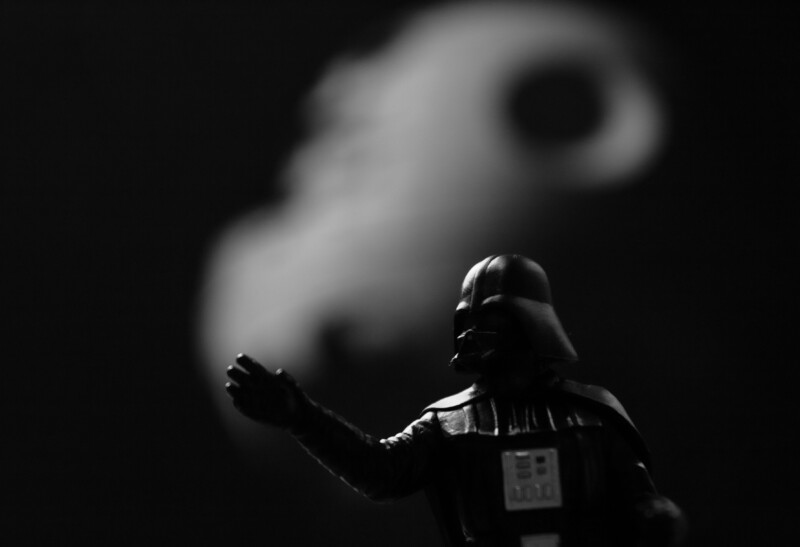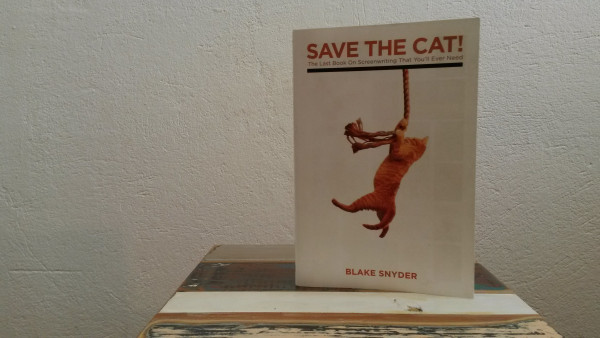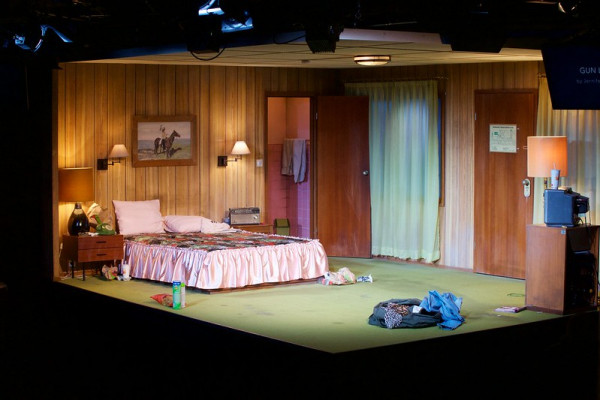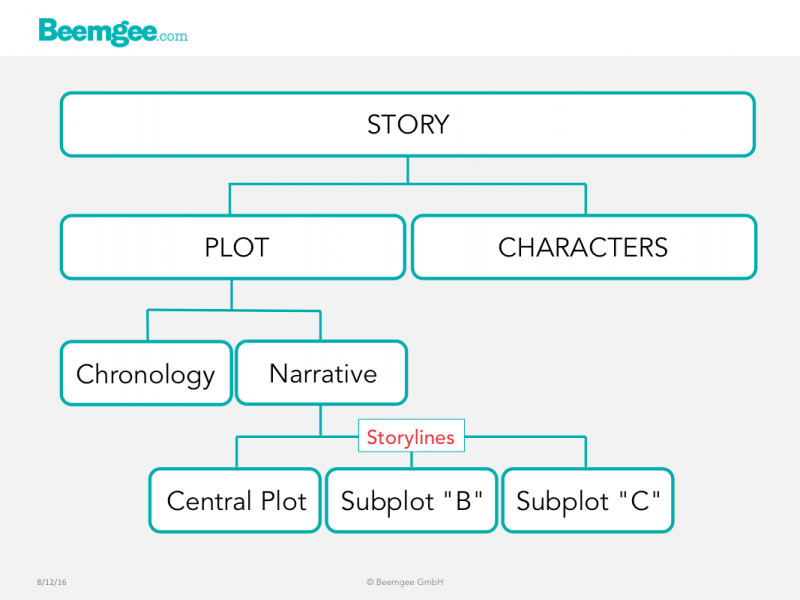
When the bad guy makes the hero’s journey difficult.
Let’s say your hero or heroine is a falsely accused fugitive from the law. While on the run, every policeman or government agent is effectively an antagonistic obstacle. This is particularly the case if there is a specific character who represents the state and whose mission it is to catch the heroine. This detective or agent casts out the net to catch the fugitive, using all the instruments of the state at his or her disposal in order to actively thwart the heroine’s escape.
Or maybe your story is about a soldier behind enemy lines on a mission to find and destroy (or steal) the enemy’s new super weapon, or perhaps rescue an important person who has been captured. Any enemy soldiers the hero encounters are, of course, obstacles. One could say that they are external obstacles if they just happen to be there, like a patrol unit. But if there is on the enemy side a character who is aware of our hero’s approach and is actively seeking to stop him achieving his mission, then the soldiers and/or henchmen this character sends out to find the hero are not external obstacles but antagonistic obstacles.
As we have said before, this division into three classes of obstacles – internal, external, and antagonistic – is not cut and dried and need not be followed too strictly. But differentiating between the different kinds of obstacles a hero or heroine must face while designing and planning your story can lead to a more exciting plot, simply because you can disperse the obstacles systematically within the story journey and have all the different kinds of obstacle build up to a great crescendo at the climax. (more…)

Guest post by Ali Luke.
 Ali Luke is a freelance writer and novelist who blogs about making the most of your writing time at Aliventures. For her best tips on making time to write, sign up for her email newsletter: you’ll receive a free copy of her mini ebook Time to Write: How to Fit More Writing Into Your Busy Life, Right Now.
Ali Luke is a freelance writer and novelist who blogs about making the most of your writing time at Aliventures. For her best tips on making time to write, sign up for her email newsletter: you’ll receive a free copy of her mini ebook Time to Write: How to Fit More Writing Into Your Busy Life, Right Now.
Pacing in fiction is how quickly—or slowly—the story progresses. The right pace for a story depends on its genre. If you’re reading a thriller, you’ll expect a fast-paced read with lots of action; if you’re reading a historical novel or epic fantasy, you might enjoy a slower pace with lots of emphasis on the world of the story.
It’s tough to get pacing spot-on when you’re drafting. It might take you years to write a book that takes just hours for someone to read. What feels “slow” to you as you write might actually go by pretty quickly on the page. Or, you may find that you repeat yourself, going over the same narrative ground multiple times, because you barely remembered what you wrote six months ago.
So, don’t worry about your pacing as you draft. Instead, address it in the redrafts—ideally, with the help of beta readers, but even simply reading over your full manuscript yourself can help you spot areas where the pace feels off.
Here’s what to look for when redrafting your work. (more…)

A story has a beginning, a middle, and an end. How to avoid the ‘saggy middle’.
The middle bit of a story is really the story proper. It is usually the longest section. It comes after the introduction of the main character(s) and the setting up of the context, that is the world of the story, as well as the problems and themes the story deals with.
At the end of the first section – prior to what we’re here calling ‘the middle bit’ –, the protagonist has decided to set off on the story journey. Obviously, this does not have to be physical journey through a particular geography, but it does mean that the main character is somehow entering into new and unfamiliar terrain. In this sense, every story is a ‘fish out of water’ story. The heroine must leave the comfort zone in order for the audience to feel interest in her plight.
Some authors jump right into this unfamiliar territory, showing the run up to it in flashbacks. Anita Brookner’s heroine Edith Hope has already arrived in the Hotel du Lac in the first sentence of the novel. Gradually the reasons for her stay here are revealed as the reader progresses through the novel.
Nonetheless, for an author, it may be advisable to create a marked threshold where the protagonist enters into the alien territory of the middle bit. The exploration and transversal of this territory is what on a plot level the middle bit is about, and it takes up the greater part of the story journey. (more…)

The midpoint is structurally the most significant point in a narrative.
Given that stories have a tendency to symmetry, the centre of a narrative should mark the zenith of the story arc, and with that, the pivotal point of the story.
So, to get to (mid)point: What happens in the middle of a story?
Here are some typical midpoint events:
- Something searched for is found (Star Wars IV, Raiders of the Lost Ark, Lolita)
- A hidden truth is unveiled (to the audience, at least) – if not yet understood (Matrix, Pride and Prejudice, The Gruffalo)
- A dramatic event thwarts all plans made hitherto (James Cameron’s Titanic)
The centre of the narrative may be the discovery of something missing – in crime stories a vital piece of the puzzle may be revealed here (either to the audience or to the audience as well as the protagonist).
In any genre or dramatic category, the midpoint may be a moment of truth. This might be just a clue for the audience or perhaps an initial revelation of the true state of things.
If a character realises or finds out something that has so far been hidden, then this is the point at which the character begins to gain awareness. This counts in particular for the recognition of the character’s own internal problem. From here on the story might possibly lead up to a moment of choice at the crisis, when it becomes clear to the audience whether the character has learnt from this new awareness or not. In other words, the real need begins to overcome or supplant the character’s initial want due to what happens at the midpoint.
Some well-known examples of the midpoint
(more…)
 Today’s guest post is by author Stefan Emunds.
Today’s guest post is by author Stefan Emunds.
Stefan’s favorite genre is visionary fiction – stories that have an enlightenment dimension. Enlightenment and storytelling have interesting parallels, which prompted Stefan to write a book about storytelling – The Eight Crafts of Writing.
Get a glimpse of his approach to story craft in his article.
Art and Craft
Storytelling is both art and craft, authoring and writing, plotting and pantsing.
1.1 Art and Authoring
Art is creativity. Creativity requires receptivity to the Muse and its inspirations.
Inspirations arrive as thought-images, which writers put into words. How to turn thought-images into words and assemble those into a structured story with vivid characters and an engrossing world is a matter of craft and skill.
1.2 Craft and Writing
The literal meaning of Kung Fu is a discipline achieved through hard work and persistent practice. Writing is Kung Fu.
Craft gives form to inspirations. Forms limit. Writers love the artistic side of writing, less so crafting, in particular, Story Outline. Writers are prone to procrastinate crafting.
But no limitations, no story. No canvas, no painting. No net, no tennis.
Understanding the difference between freedom and dominion helps to appreciate the constraints of craft. Freedom is a means to an end. We want to be free to do something, for example, to write a book. That’s all there is to freedom. Dominion, on the other hand, is mastery of structure. (more…)

Nothing should be more important to an author than how their story makes the audience feel.
As an author, consider carefully the emotional journey of the reader or viewer as they progress through your narrative.
The audience experiences a sequence of emotions when engaged in a narrative. So narrative structure is a vital aspect of storytelling. The story should be touching the audience emotionally during every scene. Furthermore, each new scene should evoke a new feeling in order to remain fresh and surprising.
The author’s job is to make the audience feel empathy with the characters quickly, so that an emotional response to the characters’ situation is possible. Only this can lead to physical reactions like accelerated heartbeat when the story gets exciting. We have to care.
This “capturing” of the audience, making the reader or viewer rapt and enthralled, requires authors to create events that will show who the characters are and how they react to the problems they must face. The audience is more likely to feel with the characters as the plot unfolds when the characters’ reactions to events reveal something about who they really are – and how they might be similar to us.
One Journey to Spellbind Them All
Here we present a loose pattern that we think probably fits for any type of story, whatever genre or medium, however “literary” or “commercial”. It’s not prescriptive, just a rough checklist of the stages in the emotional journey the audience tacitly expects when they let themselves in on a story. The emotions are in more or less the order they might be evoked by any narrative.
Curiosity
(more…)

There are two definitions of story beat. Both of them refer to a change.
One use of the term beat refers to the subtle change in the dynamic of a relationship that a line of dialogue brings about in a scene. There are usually several beats within a scene, each a marker for pushing the scene forwards dramatically.
The other meaning of the word beat in storytelling applies to changes in the plot brought about by scenes. A plot is a succession of events linked causally, a narrative chain of cause and effect. One event effects a change, determining what happens in subsequent scenes. Writers might arrange these events on a board or “beat sheet” during the planning phase. (more…)

Dramaturgy means “the craft or the techniques of dramatic composition”.
In other words, everything to do with the story except the words with which it is told. If your story is about two people in a room, dramaturgy tells you who these people are and what happens in the room. In terms of storytelling process, the term dramaturgy refers to the planning or outlining stage rather than the execution or writing.
The study of dramaturgy has produced a nomenclature that is used by dramaturges, script consultants, story advisors, editors and publishers, producers and filmmakers, as well as authors. Some terms may seem more familiar than others, and often their definitions are not entirely agreed upon. (more…)

By Lucia Tang.
Lucia is a writer with Reedsy, a marketplace that connects authors with editors, designers, and marketers. In Lucia’s spare time, she enjoys drinking coffee and planning her historical fantasy novel.
Whether we’re piecing together the timeline for a homicide or puzzling out the intricacies of Newtonian mechanics, cause and effect are crucial to how we make sense of, well, everything. Of course, I say “we” loosely. As writers, most of us won’t actually be catching killers or solving the coefficient of fiction. But still, stories are no exception to this rule: without cause and effect, they fall apart.
At the end of the day, writers should have as tight a grasp on causality as any detective or physicist. It doesn’t matter if you’re working on a doorstopper to rival War and Peace, or a breezy picture book for baby bookworms: you’ll need to craft a storyline that makes sense. This makes your readers want to spend time in the world you’ve created — and ensures they’ll leave it feeling enlightened and satisfied.
Of course, you can get there haphazardly, writing juicy scenes as they come to mind and attacking the chaos of your draft with a merciless red pen. But if you want to save time during the editing process, keep cause and effect in mind as you plot. (more…)
What do we mean when we talk about story structure?
A story is a complex entity comprising many interrelating parts. The author imposes some sort of organising principle onto the material, turning the story into a narrative. The result of this forming or shaping of the material is the story structure.
Certain structural markers are so explicit that the audience is aware of them, such as chapters in novels. Elizabethan plays are typically divided into five acts. A film script is broken down into acts, sequences, and scenes.
The beat is the smallest unit of story, below the scene in the structural hierarchy. It is the space between an action and the reaction it causes within a scene.
- Beat
- Scene
- Sequence
- Act
- Story
A plot event is not part of this traditional hierarchy, being more of a meta-unit somewhere between beat and scene.
Scenes and acts are defined in screenplays, like chapters in novels. But stories have structures that are not usually made obvious or explicit.
Beats
There are two different understandings of the term beat.
A scene may be broken down into beats – marked only by the moments when the mood or relationship the scene describes changes. Two characters are having a conversation, character A says something which makes character B react in a different way from what A expected – that’s a beat.
The term beat is also sometimes used when marking such changes on a bigger scale, across an entire narrative. Some screenwriters work with so-called beat sheets; in the Beemgee outlining tool, the plot event cards are perfect for creating beat sheets, since each card is designed to stand for one plot event. In a beat sheet, a beat is one unit of plot. If you think of narrative as a chain of events, then each beat is a single link. In one school of thought, a Hollywood movie is ideally constructed of exactly 40 such beats. (more…)
A plot arises out of the actions and interactions of the characters.
On the whole, you need at least two characters to create a plot. Add even more characters to the mix, and you’ll have possibilities for more than one plot.
Most stories consist of more than one plot. Each such plot is a self-contained storyline.

The Central Plot
Often there is a central plot and at least one subplot. The central plot is usually the one that arcs across the entire narrative, from the onset of the external problem (the “inciting incident” for one character) to its resolution. This is the plot that is at the(more…)
The term motif refers to any recurring element – in storytelling as in music or other arts.
Examples of elements that turn up repeatedly within a whole are an image on a tapestry or a particular sequence of notes in a symphony. The dispersal of these elements creates a pattern. It is therefore part of the artist’s craft to have some sort of design principle determine this pattern.
What motifs do
Motifs do not make a plot. But since they make patterns they are part of the structure of a story. And they help add a layer of meaning.
In other words, if a motif is present excessively in the first half of a story, and hardly at all in the second, then the author had better be aware of a reason for this uneven distribution. The distribution – the pattern – carries meaning to the audience. Remember, the audience yearns for meaning, is always striving to understand what the story is trying to convey at any given point. This demand for some sort of raison d’être for each element of a story, or for a sense of order within the whole, may well be unconscious to the audience much of the time, but ultimately the experience of the story is more satisfying when the audience can work out reasons and meaning.
In stories, motifs can be almost anything. Objects, actions, metaphors, symbols, colours, or images can be motifs. What defines an element as a motif is the systematic deployment within the story rather than the thing itself.
How motifs work
Motifs work best when(more…)
In essence, there are three kinds of opposition a character in a work of fiction may have to deal with:
- Character vs. character
- Character vs. nature
- Character vs. society
However, this way of categorising types of opposition is not equivalent to internal, external and antagonistic obstacles. Any of the three kinds of opposition listed above may be internal, external, or antagonistic. It depends on the story structure.
External opposition
In any story, the cast of characters will likely be diverse in such a way as to highlight the differences and conflicts of interests between the individuals. In some cases, certain roles may be expected or necessary parts of the surroundings, i.e. of the story world. In the story of a prisoner, it is implicit that there will be jailors or wardens, whose interest it will be to keep the prisoner in prison, which is in opposition or conflict with the prisoner’s desire for freedom.(more…)
Events propel narrative. Narrative consists of a chain of events.
These do not have to be spectacular action events – they can be internal psychological events if your story is about a man who does not leave his room, or spiritual events if you are recounting the story of Buddha sitting beneath the tree. But events there must be if there is to be a story.
In this post we’ll discuss –
Events in a story are effectively bits of knowledge the author wants to impart – in a particular order, the narrative – to the recipient, i.e. the reader or audience. The story is told when all the pertinent knowledge has been presented, when all the bits of information necessary for the story to feel like a coherent unity are conveyed. An author(more…)
In stories, characters are faced with obstacles.
These obstacles come in various forms and degrees of magnitude. And they may have different dimensions: they may be internal, external, or antagonistic.
Often the obstacles that resound most with a significant proportion of the audience are the ones that force the main characters to face and deal with problems within themselves, in their nature. In other words, with their internal problem.
Internal obstacles are the symptoms of the characters’ flaws or shortcomings, i.e. of the internal problem. The audience perceives them in scenes in which the character’s flaw prevents her progress.
Not every story features characters with internal problems. An internal problem is not strictly speaking necessary in order to create an exciting story.
But it helps.
The Emotional Truth
An internal problem makes the character appear fallible – and thus more credible, more human, more like us. Internal problems are invariably emotional and private. They express(more…)
More than any other part of a story, the beginning has to grab the audience’ or reader’s attention.
In the beginning, before audience or readers are emotionally involved and concerned about the fates of the characters, the danger of them turning away from the story is greatest.
Now, there’s more to a beginning than the kick-off event. While being an attention grabber, the entire first section of a story also has to establish the following:
- Who the story is about
- What the story is about
- Where the story takes place
That sounds self-evident, but all the elements needed to answer those three points amount to an awful lot of information. And at this stage, the audience or readers are not yet patient or forgiving, because they are not yet emotionally hooked.
In this post we will:
- look at the who/what/where
- determine the three key events that the first section of a story must include
- provide a checklist of all the elements the first part of a story requires
Who/what/where
(more…)

How to describe a full plot event.
We’ll talk here about describing events, since the usual term scene is more general and has different meanings for different media. Furthermore, a scene may conceivably contain more or less than one entire event.
An event in a story requires three elements: characters, function, and (perhaps most importantly) a difference between expectation and result.
In describing each plot event, it is useful to consider the six wh- questions as a guide: Who does what to whom, where, when and why? With this approach, each plot event gains its own logline, which is a good exercise since it forces you as an author to figure out just what dramatic function each plot event has in the context of the overall narrative.
Viewing the overall narrative, certain plot events can function as beats. More on this structural function of plot events here.
Characters
Characters causing events make story. As(more…)
Inventing a story that has no backstory is about as easy as finding a perfect rhyme for the word orange.
That is, next to impossible.
Backstory is the stuff that went on before the story begins, or more precisely, before the kick-off event in scene 1. As such, backstory might better be called “pre-story”. It is a necessary component of any story.
After all, the characters come from somewhere – they have pasts, they have histories. These histories have shaped them into who they are, which determines their actions now, in the time of the story. These actions are the source of the events of the story. So some part of the characters’ histories will be relevant to the story – and this bit of information or knowledge needs to be passed on to the audience or reader. That’s why so many stories have “campfire scenes”, a moment of calm usually near the beginning of the second half during which characters recount stories of their pasts to each other. (more…)

Narrative consists of successive events.
One recognizable convention from film is what we might call the kick-off event. It is the opening scene, the very first item in the narrative. This is not to be confused with the inciting incident.
We’ll refer to the kick-off event as the initial scene, and whatever the medium – page, stage, or screen – it ought to capture the audience’s or reader’s attention.
The kick-off event can be drawn from virtually anywhere in the event chronology – like a “capsule” of plot pulled out from the narrative (more on that below). It may open up some questions to arouse our curiosity, or tell us something about a major character that will become relevant much later. It can throw the audience or reader, the recipient of the story, in medias res, straight into the middle of an exciting event. Or it can build up slowly to set the scene and establish a mood.
This first event(more…)













